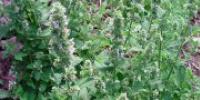The beet root is a modified root. Root modifications and their functions
The root of the plant performs many functions. The most important of them for the life of the plant are the retention of the plant in the soil and the absorption of water with dissolved minerals. In addition to the above roots, it is also characteristic to perform a number of other functions, which is why their structure is modified. Due to metamorphosis, the modified root loses its similarity with the usual root.
Root crop
In some biennial plants (turnips, parsley, carrots), the root is transformed into a root crop, which is a thickened adventitious root. The main root and the lower section of the stem take part in the formation of the root crop. In the structure of the root crop, the main place belongs to the storage main tissue.
Depending on the structure of the root, three types of root crops are distinguished: carrot, beet and rare.
1. Carrot-type root crops - vegetables with an elongated root, which can be cylindrical, conical, elongated - conical, fusiform and blunt or sharp end. Root crops of this type have a clearly differentiated bark (phloem) and core (xylem). Between them is a cork cambium. From above, the root crop is covered with a natural periderm. In terms of composition and amount of nutrients, the bark is more valuable than the core. Root crops of this type include carrots, parsley, celery, parsnips.
2. Beet roots - vegetables with rounded, round-flat, oval or elongated roots. Represented by table and sugar beets. As a vegetable crop, only table beets are used. The root crop has dark red flesh with rings of lighter toga, which is due to the alternation of xylem (light rings) and phloem (dark rings) tissues. The less the specific gravity is occupied by xylems, the higher the nutritional value beets.
3.
Rare root crops
- vegetables with rounded, turnip-shaped, elongated-conical roots. A feature of their internal structure is the radial arrangement of the secondary xylem, phloem and parenchymal tissue. The cambial layer is located directly below the periderm. Root crops of this type include radishes, radishes, rutabaga and turnips.
Root crops of all types are characterized by common morphological features: the head in the upper part with leaf petioles and buds at the base, the root body (the main edible part) and the tip of the root (the main one), and beet-type root crops have side roots. In other root crops, thin lateral roots are easily torn off during harvesting and, as a rule, are absent.
A feature of all root crops is their ability to heal mechanical damage by cell suberization, as well as their easy digestibility. The most easily fading are carrot-type root crops, radishes, the least - beets, radishes, turnips and rutabaga.
Root tubers (root cones)
Many angiosperms have root tubers (or root cones) on their roots. Their origin is associated with a thickening of adventitious and lateral roots. Root tubers are a container nutrients. They are also used for vegetative propagation of plants.
The most famous of the plants with a typical root tuber is the dahlia. Swollen root cones extend from one point - the base of the old stem. These modified roots provide the plant with nutrients. During the growth period, their own thin roots grow from them, which extract water and nutrients from the soil. Plants with root cones are propagated by individual cones with a bud (eye) at the end (dahlia, eremurus, clivia, buttercup).
Hook roots, stilted roots, aerial roots, plank roots, sucker roots
Ivy. Photo: Garry Knight
Roots-hooks- a kind of adventitious roots that allow the plant to easily attach to any support. Such roots are found in ivy and other climbing plants.
An amazing phenomenon in nature is the stilted roots, which serve as a support for the plant. Such roots have the ability to resist strong loads, due to the presence of mechanical tissues in all departments. They are found in plants of the genus Pandaus, growing on oceanic islands in the tropics, where strong hurricane winds prevail.
Air (respiratory) roots found in tropical trees that grow in oxygen-depleted soils, freshwater tropical swamps. These are lateral roots located above the ground. Thanks to aerial roots, oxygen and water are absorbed by the plant from the air in conditions of high humidity. So the respiratory roots provide the function of additional respiration.
plank roots - These are vertical above-ground roots characteristic of large trees growing in tropical rainforests. They develop at the base of the trunk, look like boards adjacent to the trunk, providing the plant with additional support.
Mycorrhiza
Mycorrhiza is a symbiosis of roots higher plants with fungal hyphae. This cohabitation is beneficial for both organisms, since the fungus receives ready-made organic substances from the plant, and the plant absorbs water with minerals from the fungus. Mycorrhiza is often found on the roots of higher plants, especially woody ones. One can imagine fungal hyphae intertwining with thick tree roots as root hairs, since their functions are similar.
Most of the perennials have mycorrhiza. It is assumed that mycorrhiza is one of the factors that contributed to the progress of flowering plants. Plants that feed on mycorrhizal fungi are called mycotrophic.
There are two main types of mycorrhiza: ectotrophic and endotrophic. The hyphae of ectotrophic mycorrhiza cover the root only from the outside, sometimes penetrating into the intercellular spaces of the cow parenchyma. Ectomycorrhiza is common in many woody (pine, birch, oak, beech, etc.), as well as a number of herbaceous agricultural plants, especially in cereals. The fungus settles on the germinated seed root and in further development, especially in the tillering phase, provides abundant soil nutrition for the plant.
Endotrophic mycorrhiza is more common. It is characteristic of most flowering plants. Endomycorrhiza does not form a fungal sheath around the root, the root hairs do not die off, but the hyphae penetrate the root and invade the cells of the cow's parenchyma.
Epiphytic tropical orchids and some other plants have so-called aerial roots. They cover with a multi-layered epiblema called velamen. Velamen sometimes performs a photosynthetic function, and later it can participate in the absorption of atmospheric moisture, forming a dead spongy hygroscopic root cover.
Without mycorrhiza, the mycelium of symbiotic fungi can exist in the soil for a certain time, but will never form fruiting bodies. Therefore, under artificial conditions, it is impossible to obtain fruiting bodies of white fungus, russula mushrooms, fly agarics - they are all mycorrhiza-forming, and without a certain tree species they will not bear fruit. In turn, a plant without its fungal symbionts develops poorly, slowly, easily exposed to diseases and may even die.
Mycorrhiza is of great importance in tropical rainforests. Due to the strong leaching regime (daily rainfall), these forests are practically devoid of soil (all nutrients are washed out of the soil). Plants face an acute problem of nutrition. At the same time, there is a lot of fresh organic matter: fallen branches, leaves, fruits, seeds. But this organic matter is inaccessible to higher plants, and they come into close contact with saprotrophic fungi. Thus, the main source of minerals under these conditions is not soil, but soil fungi. Minerals enter the root directly from the hyphae of mycorrhizal fungi, which is why rainforest plants are characterized by a shallow root system. How effectively mycorrhiza works can be judged at least by the fact that tropical rainforests are the most productive communities on Earth, the maximum possible biomass develops here.
bacterial nodules
Also, plants can mutually cohabitate with nitrogen-fixing bacteria. So, bacterial nodules appear on the roots of higher plants - modified lateral roots that have adaptations for symbiosis with bacteria. Through the root hairs, bacteria enter the young roots and provoke the formation of nodules. The role of these bacteria is that they convert nitrogen from the air into a mineral form so that it becomes available for absorption by plants. Plants perform the function of protecting bacteria from competing soil bacteria. Bacteria also feed on substances from the roots of higher plants. The appearance of nodule bacteria was recorded, mainly on the roots of plants from the legume family. Therefore, legume seeds are enriched with protein, and in agriculture representatives of this family are used in crop rotation to enrich the soil with nitrogen.
It is difficult to overestimate the importance of the underground organ of plants. After all, it reliably holds even huge trees in the soil, provides them with water and a sufficient supply. environment require additional functions. And then there is a modification of the root.
Root and its structure
According to the structural features, several types of roots are distinguished. The main root acts as a pivot. It is easy to distinguish it from others. A plant has only one. Lateral branches depart from the main root. They are needed to increase the surface area of the soil in order to be able to absorb more moisture. The root system, consisting of such roots, is called the pivot. Roots that grow directly from the shoot (above-ground part of the plant) are called adventitious. Their bundle forms
Modifications of plant roots
The classical system makes it possible to perform only certain functions. For the survival of plants in difficult conditions, a modification of the root is necessary. Let's consider each of them in more detail.
Roots
Everyone remembers the fairy tale about tops and roots. Such a modification of the root, like root vegetables, is an example of tasty and juicy roots. Carrots, radishes, turnips, beets... It is impossible to imagine one day without the presence of these healthy and tasty foods in our diet.
They are the result of thickening of the main root of the rod system. In order to survive the cold autumn and winter and form seeds, the plant stores water with minerals underground. And a person uses juicy root crops for food.

root tubers
What is a modification of the root can also be considered on the example of root tubers. This is also a thickening of the roots. But not the main one, but the adventitious roots of the fibrous system. As a result, the underground beam becomes powerful and heavy due to a significant supply of water. It occurs in dahlia, asparagus, cinquefoil, sweet potato.
An additional function of root tubers is vegetative reproduction. It is possible due to the presence of adnexal buds on these modifications, which are often also called root cones.

aerial roots
The conditions of growth and modification of the roots are inextricably linked. grow in conditions of high humidity. Such plants do not need to get moisture from the soil, since there is enough of it in the air. For example, an orchid grows directly on tree trunks from which aerial roots hang. Absorbing water directly from the air, they provide the plant with this essential substance with the help of aerial (respiratory) roots. Ficus, fat woman, monstera are indoor plants that also form aerial roots. For their normal development, sufficient humidification of the air in the room is necessary.
prop roots
A root-support is also a modification of the root. The name itself speaks of the functions it performs. Indeed, strong adventitious roots, like an artificial mount, hold the shoot. They are often seen in corn. The shoot of this plant with fruits is quite weighty. And fibrous has rather superficial roots that are not able to hold the plant during strong gusts of wind. This is where a special device comes to the rescue - support roots.

Many saw a man on stilts in the circus, but in nature, plants can be found on such devices. Stilted roots are like props, but grow from the shoot down. At the mangroves rainforest they additionally perform the function of absorbing moisture from the air. The plants of the tidal zone seem to be lifted above the water, ensuring their normal functioning.

Attachment roots
The well-known ivy is able to occupy any surface. Even a vertical rock will not be a special obstacle for him. He acquired this ability due to the presence of adventitious trailing roots that can attach to any surface.
Everyone knows that the boletus grows under a birch, and the boletus grows under an aspen. But not everyone understands why this is so. The fact is that the roots of some plants cohabitate mutually with fungi. From such a symbiosis is good for everyone. Mushrooms receive organic substances from the tree, which they cannot produce on their own, since they are incapable of photosynthesis. And trees with the help of fungi are provided with water with a solution of inorganic substances.
Modification of the root helps the plant survive in conditions of deficiency or excess of moisture, better hold in the soil, attach to a support and remain viable for a long time, giving an excellent harvest.
Man has long since learned to use them in his work. Root crops containing a large amount of valuable vitamins and minerals are used as food. And not only in raw, but also in boiled, fried and canned form. Forage varieties of beets and turnips are grown for livestock. Sugar is obtained from a special type of beet by processing. But in parsley, it is not the bitter root that is valued, but the juicy and healing leaves of the shoot. So, changing, the roots benefit not only plant, but also animal organisms and humans.
The main functions of the root are fixing the plant in the soil and absorbing water. Sometimes the roots perform other, non-typical functions. In this regard, they have an atypical structure, in other words, such roots are characterized by modifications, or metamorphoses (from the Greek. Metamorphosis - transformation).
Roots
Root crops are distinguished by the presence a large number storage tissue. They usually form in biennial plants in the first year of life. In the second year, flowers, fruits, seeds are formed. Thus, the root crop allows the plant to transfer the dormant period and complete development for the next year.
Root crop is a conditional name. It has nothing to do with fruits, because it is formed not from a flower, but from vegetative organs- stem and root.
The ratio of the stem and root during the formation of root crops is different, for example, in carrots, almost the entire root crop is formed by the root, and in turnips by the stem.
Modern root crops are bred by man artificially. They play an important role in its nutrition, as well as in the feeding of animals.
root cones
If the root crop is a thickened main root, then the root cones are strongly thickened adventitious and lateral roots. For them, as well as for root crops, a developed storage parenchyma is characteristic. Root cones form adventitious buds, therefore they are organs of vegetative propagation.
TOP 4 articleswho read along with this
Aerial roots are found in many tropical epiphytes (plants that use trees for support).

Rice. 1. Aerial roots.
Such roots hang freely in the air and absorb moisture in the form of rain and dew.
This type of modified roots is also found in the tropics. It is characteristic of trees growing on the swampy coasts of the oceans. The root system of such plants is complex and has an air-bearing tissue aerenchyma. Through the holes, air enters the aerenchyma and then passes to the remote underwater parts of the plant.

Rice. 2. Respiratory roots.
stilted roots
Stilted roots, or prop roots, are formed in plants growing on unsteady, muddy soil. They distribute the mass of the plant to the increased area of \u200b\u200bsupport due to them.
columnar roots
The peculiarity of columnar roots is that they are laid on the branches. Such roots of shoots for a banyan tree are characteristic.
Banyan is not the name of a plant. This is the name of the growth features of some ficuses. You can call a banyan tree any tree with a voluminous crown, based on columnar roots.

Rice. 3. Indian banyan.
Mycorrhiza
Mycorrhiza is a symbiosis of roots and fungi. It represents the roots with the hyphae of the fungus that have penetrated into them. Cohabitation with a fungus has a number of beneficial consequences for the plant:
Total ratings received: 212.
Root modifications. You already know that the main functions of the root are the fixation of the plant in the soil, the absorption of solutions of mineral compounds from the soil and their transport to its aerial parts. However, the root can perform some additional functions. At the same time, it acquires certain structural features, called root modifications.
In many plants (for example, beets, carrots), reserve nutrients are deposited in the main root and base of the shoot. As a result of this, the main root thickens and turns into a root crop. In other plant species (for example, dahlia, spring chistyak, sweet potato), reserve nutrients are deposited in additional or lateral roots, which acquire a tuberous shape. Such modifications are called root tubers.
In some plants growing in swamps and waterlogged soils, respiratory roots are formed. These are lateral roots growing upward and rising above the surface of the soil (or water). In waterlogged soils, due to the low oxygen content, the respiration of the underground part of the plant becomes more difficult. Therefore, such modified roots absorb oxygen directly from moist air.
There are also trailing roots. These are short additional roots growing along the aerial part of the stem. With their help, climbing stems of plants cling to a support. Remember ivy, which can attach itself even to the smooth vertical walls of houses. There are also supporting roots that act as props.
A special type of root modification is observed in orchids. Some species of these plants are able to settle on tree trunks of tropical rainforests. But, unlike dodder or mistletoe, orchids do not feed on tree sap. Their aerial roots hang freely and allow them to draw water from moist air.
The significance of root modifications in plant life and human economic activity. We already know that root modifications are associated with the adaptation of plants to certain places of growth. For example, root crops develop in many biennials (carrots, parsley, beets) and some perennials (horseradish) plants. During the first year of life in these plants, only leaves are formed above the soil, located on a shortened stem. The organic compounds formed in them gradually accumulate in the main root, which at the same time thickens and turns into a root crop. In winter, the leaves die off, and the roots hibernate in the soil. In the second year, due to the stored nutrients, flowers and fruits are formed in plants. Root tubers play the same role in plant life.
For two years of life in these plants, only leaves are formed above the soil, located on a shortened stem. The organic compounds formed in them gradually accumulate in the main root, which at the same time thickens and turns into a root crop. In winter, the leaves die off, and the roots hibernate in the soil. In the second year, due to the stored nutrients, flowers and fruits are formed in plants. Root tubers play the same role in plant life.
A person uses root crops for food (carrots, beets, turnips, radishes, parsnips, parsley, horseradish), for pet food (fodder beets, turnips, turnips), as raw materials for the food industry (sugar beet).
Pesticides, chemical compounds that serve to protect plants from pests and diseases, have a harmful effect on soils and their inhabitants. Excessive and incorrect use of them leads to environmental pollution.
The main root of the desert bush camel's thorn reaches a depth of 15 m, on which the aquifer of the soil is located.
The soil for 30-40% consists of cavities filled with a mixture of gases. The composition of this mixture may differ from the composition of atmospheric air: with increasing depth, the content of oxygen in it decreases, and carbon dioxide increases (up to 1%, while in air it is only 0.03%). In dense soils
Performs many functions. The most important of them for the life of the plant are the retention of the plant in the soil and the absorption of water with dissolved minerals. In addition to the above roots, it is also characteristic to perform a number of other functions, which is why their structure is modified. Due to metamorphosis, the modified root loses its similarity with the usual root.
In some biennial plants (turnips, parsley, carrots), the root is transformed into a root crop, which is a thickened adventitious root. The main root and the lower section of the stem take part in the formation of the root crop. In the structure of the root crop, the main place belongs to the storage main tissue.
Roots-hooks- a kind of adventitious roots that allow the plant to easily attach to any support. Such roots are found in ivy and other climbing plants.
An amazing phenomenon in nature - stilted roots, which act as a support for the plant. Such roots have the ability to resist strong loads, due to the presence of mechanical tissues in all departments. They are found in plants of the genus Pandaus, growing on oceanic islands in the tropics, where strong hurricane winds prevail.
Air (respiratory) roots found in tropical trees that grow in oxygen-depleted soils, freshwater tropical swamps. These are lateral roots located above the ground. Thanks to aerial roots, oxygen and water are absorbed by the plant from the air in conditions of high humidity. So the respiratory roots provide the function of additional respiration.
Mycorrhiza is a symbiosis of the roots of higher plants with fungal hyphae. This cohabitation is beneficial for both organisms, since the fungus receives ready-made organic substances from the plant, and the plant absorbs water with minerals from the fungus. Mycorrhiza is often found on the roots of higher plants, especially woody ones. One can imagine fungal hyphae intertwining with thick tree roots as root hairs, since their functions are similar.
Also, plants can mutually cohabitate with nitrogen-fixing bacteria. So on the roots of higher plants appear bacterial nodules- modified lateral roots that have adaptations for symbiosis with bacteria. Across root hairs bacteria get inside the young roots and provoke the formation of nodules. The role of these bacteria is that they convert nitrogen from the air into a mineral form so that it becomes available for absorption by plants. Plants perform the function of protecting bacteria from competing soil bacteria. Bacteria also feed on substances from the roots of higher plants. The appearance of nodule bacteria was recorded, mainly on the roots of plants from



